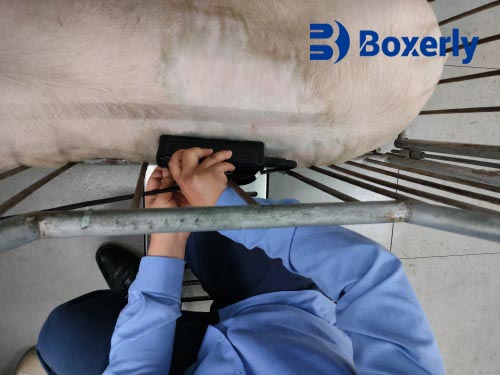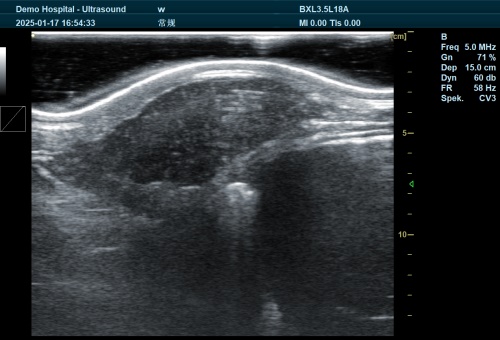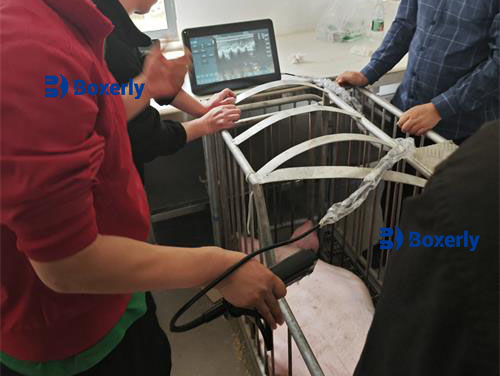The Impact of Ultrasonic Detection of Fat and Backfat on Sow Estrus: A Practical Insight
As modern pig farming moves toward greater precision and efficiency, veterinary ultrasound has emerged as a crucial diagnostic tool. Beyond pregnancy detection and fetal monitoring, ultrasound is increasingly used to evaluate fat deposition and backfat thickness in breeding sows—key indicators that influence reproductive performance. Understanding the relationship between a sow’s energy reserves and estrus return is essential for improving farrowing intervals, fertility, and overall productivity. In this article, we explore how ultrasonic detection of fat and backfat can inform better nutritional and reproductive management in sows, with reference to both global research and practical field experience.

1. Understanding Energy Balance and Estrus Return in Sows
Reproductive efficiency in sows is closely tied to their energy status. During lactation, sows experience an enormous energy demand to support milk production. When dietary energy intake is insufficient, the sow begins mobilizing body reserves, notably fat and protein, to meet these needs. While some degree of tissue mobilization is normal, excessive loss can delay or even prevent post-weaning estrus.
Studies from the U.S. and Europe show that lactation-induced negative energy balance correlates strongly with delayed follicular development, which can be visualized via B-mode ultrasound. On ultrasonographic examination, affected sows may show underdeveloped or static ovarian follicles—an indication of impaired hypothalamic-pituitary-ovarian axis function.
Ultrasound thus becomes a valuable early warning system. If no growing follicles are seen within 3–5 days post-weaning, it is a sign that the sow’s metabolic recovery is inadequate. This is especially critical in high-producing sows or under restrictive feeding systems, where the reproductive system can become temporarily suppressed.
2. Dietary Fat and Its Effect on Sow Reproductive Recovery
The inclusion of fat in sow diets, particularly during late gestation and lactation, is a common strategy aimed at boosting energy density. Several studies have evaluated how different fat sources—animal vs. plant origin, saturated vs. unsaturated—affect the weaning-to-estrus interval.
Some research, including findings from Canadian and Danish swine nutrition trials, suggests that dietary fat can improve energy availability, thereby shortening the time to estrus. In practice, sows fed high-fat diets may ovulate earlier post-weaning, and ultrasound scans reveal earlier follicular growth.
However, results are not always consistent. For instance, one study comparing high-starch vs. high-fat diets during lactation found that sows fed starch-rich diets actually returned to estrus faster. Ultrasound imaging on day two post-weaning showed that the follicle size was larger in the starch-fed group, suggesting that carbohydrate availability might be more critical than fat in triggering follicular activation.
Additionally, data indicates that the timing and duration of fat supplementation—such as from 8 days pre-farrowing to 7 days post-farrowing—can influence results. Yet overall, whether using starch or fat as the primary energy source, the impact on litter size, embryo survival (seen at 35 days post-insemination via ultrasound), and piglet viability appears minimal.

3. Ultrasound Detection of Backfat Thickness and Its Reproductive Implications
Backfat thickness is widely recognized as a practical, non-invasive proxy for body condition in sows. Using ultrasound, farmers and veterinarians can measure backfat at the P2 position (last rib, 6.5 cm off the spine), a standard practice in many countries including the U.S., Australia, and the Netherlands.
Sows with moderate backfat (16–19 mm) at weaning tend to have the best reproductive outcomes. These animals demonstrate higher estrus expression, greater conception rates, and larger litter sizes. Conversely, sows that are either over-conditioned or excessively thin show impaired performance.
Over-conditioned Sows
Sows with thick backfat layers (>22 mm) may experience reduced fertility. Excess fat around the uterus and ovaries can impair blood flow and reduce the secretion of uterine-specific proteins essential for embryo survival. If the embryo count falls below a certain threshold (typically five), the uterus may release prostaglandin F2α, triggering luteolysis and the loss of pregnancy. On ultrasound, this manifests as early embryonic death and reabsorption, commonly seen as reduced embryo counts or empty uterine horns in repeat-breeder sows.
Internationally, herd managers are increasingly using B-mode ultrasound not only for pregnancy detection at day 28–35 post-insemination, but also to assess early embryo viability and identify reabsorption trends. This helps distinguish fertility issues from early gestational loss due to metabolic or anatomical problems.
Under-conditioned or Thin Sows
On the other hand, thin sows (backfat <14 mm) pose a different challenge. Low fat reserves limit the body’s ability to synthesize and store steroid hormones, such as estrogen and progesterone, which are vital for estrous behavior and ovulation. Research on female physiology, including human and animal models, suggests that falling below a critical fat threshold can disrupt reproductive function, leading to silent heats, anovulation, or even follicular cysts.
Ultrasound images in such sows often show ovarian inactivity. Follicles remain undeveloped or fail to progress to ovulation. In severe cases, sows may skip estrus entirely, extending the weaning-to-conception interval and reducing lifetime productivity. These sows also tend to produce smaller litters and fewer liveborn piglets due to inadequate follicular recruitment during the weaning period.

4. Global Perspectives on Sow Body Condition and Fertility
In large-scale swine operations across Europe, North America, and parts of Asia, the integration of ultrasound into routine sow management is becoming increasingly common. Many producers now scan sows multiple times per reproductive cycle—for pregnancy checks, embryo viability, and backfat measurement.
For example, in Canadian herds, body condition scoring using ultrasound is now standard before farrowing and weaning. By adjusting feed accordingly, farms have improved sow longevity and litter performance. In Australia, precision feeding programs combine backfat ultrasound data with automated feeders to tailor energy intake, preventing both obesity and underconditioning.
Meanwhile, in Europe, nutritionists are studying the effects of polyunsaturated fatty acids (PUFAs), such as omega-3 and omega-6, on sow reproduction. Some trials suggest that PUFAs may enhance embryo development and implantation, although evidence remains mixed. What’s clear, however, is that ultrasound remains central to monitoring how these interventions affect ovarian and uterine status in real time.
5. Ultrasound: A Decision Tool for Reproductive Management
The real-time, non-invasive nature of ultrasound gives it a unique advantage. When used correctly, it allows for:
-
Timely identification of reproductive disorders: Detecting follicular inactivity, cysts, or early embryonic loss
-
Monitoring body condition: Measuring backfat before and after weaning to adjust feed
-
Evaluating response to dietary changes: Observing how fat/starch supplements impact follicular dynamics
-
Predicting weaning-to-estrus interval: Based on ovarian appearance at weaning
This real-time feedback loop enables veterinarians and farm managers to make informed decisions about nutrition, breeding timing, and sow retention. It also supports research into novel nutritional strategies that optimize sow fertility without compromising piglet health.

6. Conclusion
Ultrasound has revolutionized how we understand and manage sow fertility. From measuring backfat to observing ovarian activity, it provides a window into the metabolic and reproductive health of the breeding sow. As this article has shown, both excessive fat and insufficient reserves can disrupt estrus and reduce productivity. The key lies in maintaining a balanced energy status throughout gestation, lactation, and the post-weaning period.
Though dietary fat and starch supplementation can help, they must be tailored to individual sow condition and closely monitored—ultrasound is the ideal tool for this purpose. With continued research and adoption of best practices globally, producers can leverage this technology to enhance sow performance, piglet survival, and overall herd profitability.
By integrating ultrasound into sow reproductive management, we move one step closer to precision swine farming—where every sow receives exactly what she needs to thrive and reproduce efficiently.





